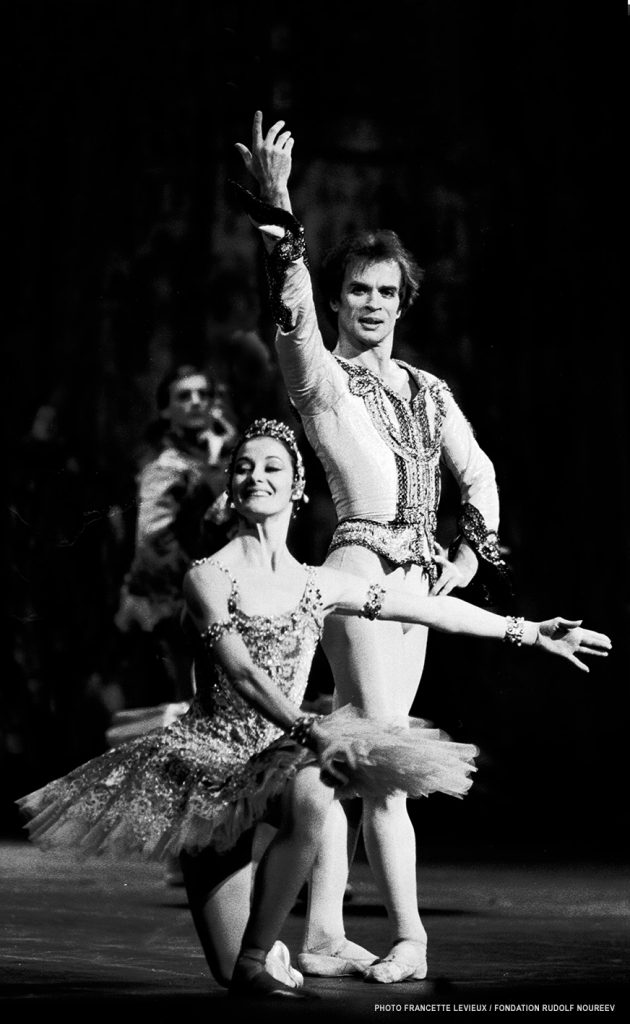
Ballet in three acts – Story by Lydie Pachkoff and Marius Petipa – Music : Alexandre Glazounov – Choreography : Rudolf Noureev after Marius Petipa – Visit the Nureyev Collection at the Centre National du Costume de Scène
Towards the end of 1958, Rudolf Nureyev was taken on by the Kirov in Leningrad at the age of 20. In March of the following year, he danced the part of one of the knights in the Pas de Quatre in the 3rd act of “Raymonda” to music by Glazunov, in Petipa’s choreography revised in 1938 by Yuri Slonismsky and Vassily Vaïnonen. Once he had defected to the West, the young Rudolf mounted this Pas de Quatre from memory for the recitals he gave in January 1962 in Cannes and Paris with Rosella Hightower, Sonia Arova and Eric Bruhn. Shortly after this, he arranged the Hungarian divertissement in the 3rd act for the Royal Ballet, for a tour he completed with Margot Fonteyn.
But above all, “Raymonda” was the first three-act ballet that Nureyev mounted in the West. He first arranged it for the Spoleto Festival in 1964 with the Royal Ballet. Margot Fonteyn – who was supposed to dance the heroine’s part – was called back to London on the eve of the Première, where her husband – a Panamanian diplomat – who had been the victim of a terrorist attack – was in a critical condition. Nureyev danced the part of Jean de Brienne with Doreen Wells who stood in for Margot Fonteyn. The French film-makers, Philippe Collin and Pierre-André Boutang filmed an extraordinary documentary entitled “Nureyev in Spoleto” all through the rehearsals, during which he admitted he had only ever danced the Pas de Quatre four times at the Kirov, where he had also seen the whole ballet four times from the audience. Based solely on these memories, he recklessly decided to produce the three acts of “Raymonda”.
The following year, Nureyev mounted this ballet – yet unknown in the West – for the Australian Ballet and this production was staged at the Champs Elysées Theatre in November 1965 with Margot Fonteyn and Rudolf Nureyev. He danced the part of the noble Jean de Brienne, who left his fiancée Raymonda to join the Crusaders in Palestine, returning in the final act with his companion in arms, King André of Hungary, just in time to wrench his fiancée from the arms of the Saracen chief Abderam, who was kidnapping her. The choreographer – who was extremely proud of his first ballet – was particularly fond of the third act and the Hungarian divertissement for the Heroes’ wedding and he succeeded in having it added to the repertoire of the Royal Ballet in London and the Norwegian Ballet in Oslo. Finally, after totally revising the story and the choreography, Nureyev created a new “Raymonda” in three acts, which was far longer than his Spoleto production, since he added several of his own, particular variations for Jean de Brienne. He created this new version for the Zurich Ballet in 1972, then added a few variations for the American Ballet Theatre in Houston in 1975. “Raymonda” was the first major ballet that Rudolf Nureyev mounted when he arrived as Ballet Director at the Paris Opera in 1983. He did not take part himself in the first performance of this final version, which was created in Nicholas Georgiadis’ sumptuous décor by eight principal dancers! Yvette Chauviré making her comeback to the stage, Elisabeth Platel (Raymonda), Charles Jude ( Jean de Brienne), Jean Guizerix (Abderam), Monique Loudières, Claude de Vulpian, Patrick Dupond and Françoise Legrée! That evening, Paris discovered two dancers who were dazzling in their virtuoso duo, which met with thundering applause: Lauren Hilaire and Manuel Legris.
With “Raymonda”, Rudolf Nureyev confirmed his genuine gift as a choreographer – which his detractors have always denied! – not only with this virtuoso duo and in several brilliant ensembles, but especially in his completely new concept of Abderam’s character. In the U.S.S.R. – as in Petipa’s Russia – this role was always mimed. Nureyev made it a major dancing role and in particular, he invented two splendid variations for Abderam in the second act, which reveal a wholly oriental sensuality, undoubtedly inspired by the folk dances he performed when he was a child in Oufa with the Pioneers of his school and by character ballets such as Nina Anissimova’s “Gayané” – which was one of his first roles with the Kirov. With an innate sense of drama, the choreographer made Jean de Brienne a kind prince, opposed to Abderam, a virile and fierce womaniser who troubled Raymonda even in her dreams. All the Opera principals danced Nureyev’s ballet – especially Sylvie Guillem and Florence Clerc – during the Paris Opera Ballet’s triumphant tour at the Met in New York in 1984. Rudolf Nureyev danced the part of Jean de Brienne many times during his career, but thoroughly enjoyed dancing Abderam, when he could give free rein to his proud Tartar temperament. Yves-André Hubert filmed the entire ballet in colour for Antenne 2 TV channel in December 1983, with Noella Pontois, Rudolf Nureyev, Jean Guizerix and the Paris Opera Ballet. An inestimable testimony to Nureyev’s art as a dancer and as a choreographer. R.S.







